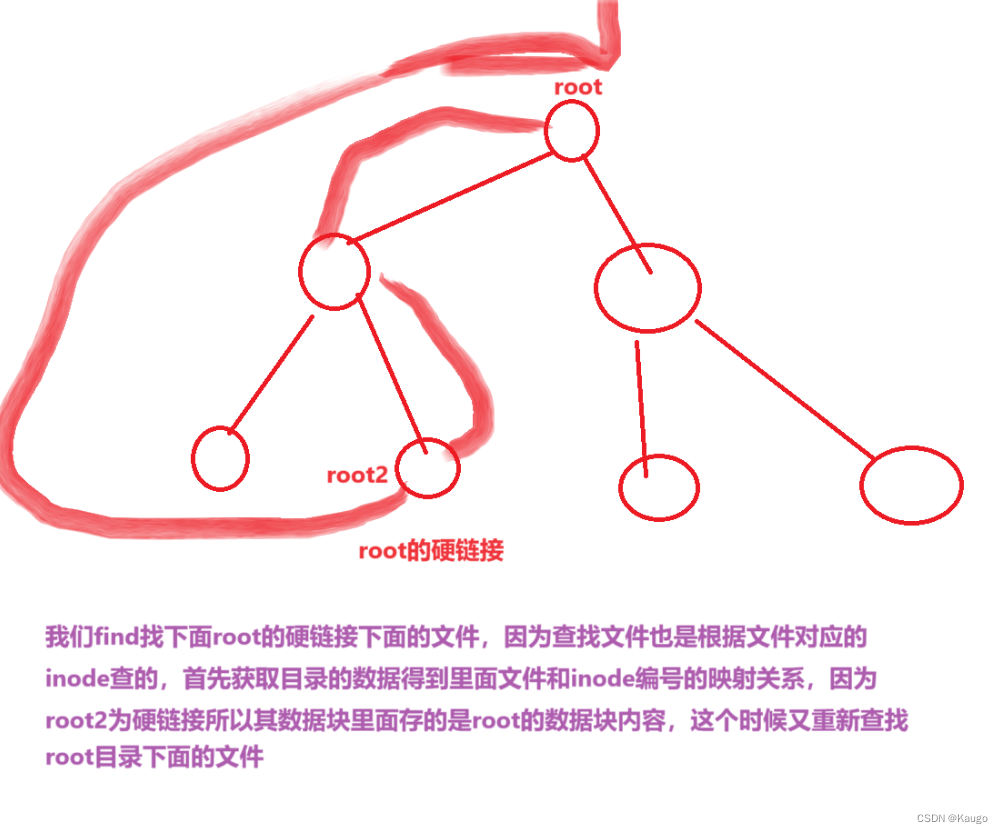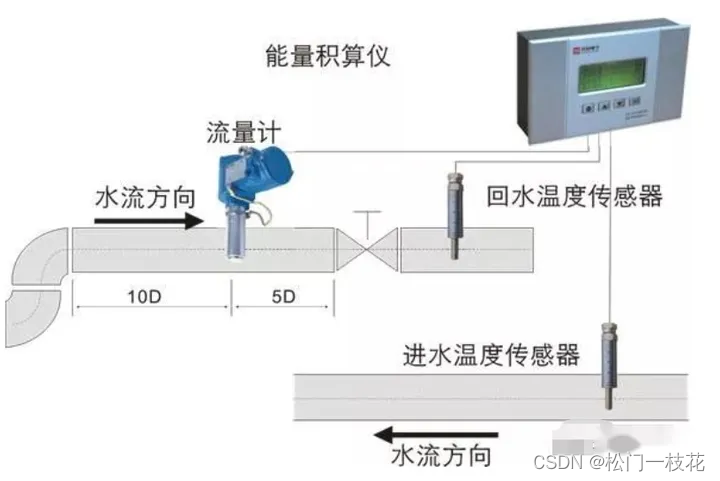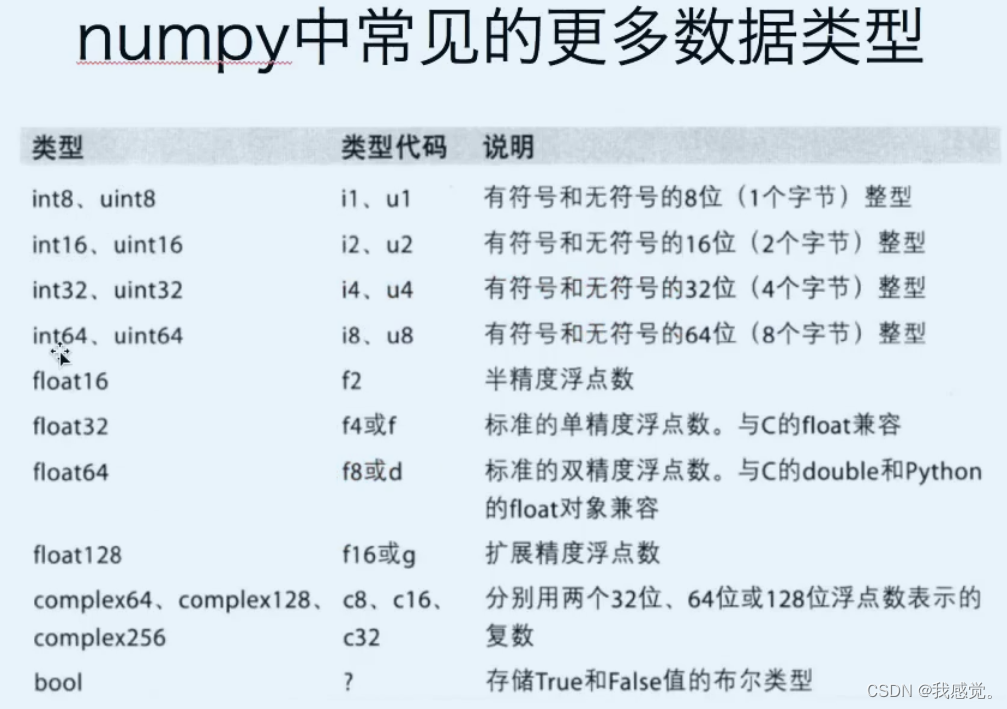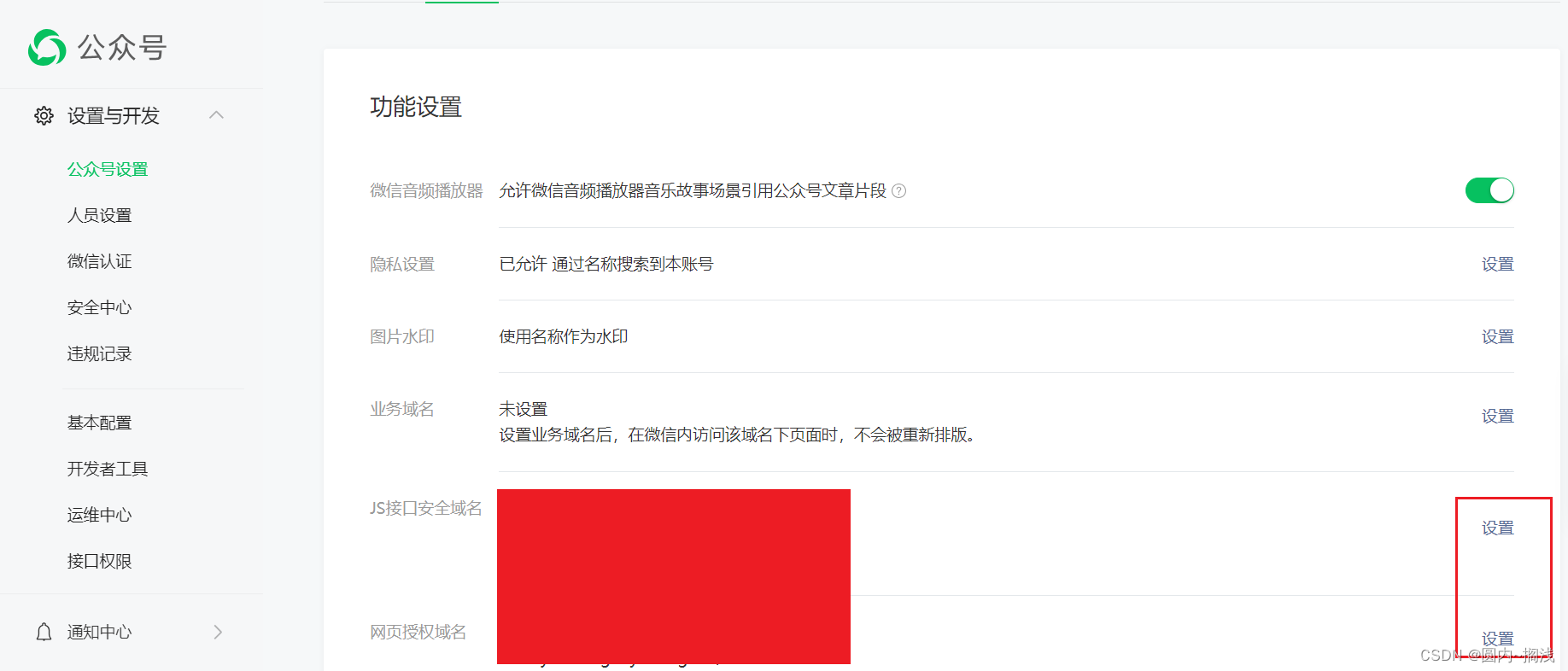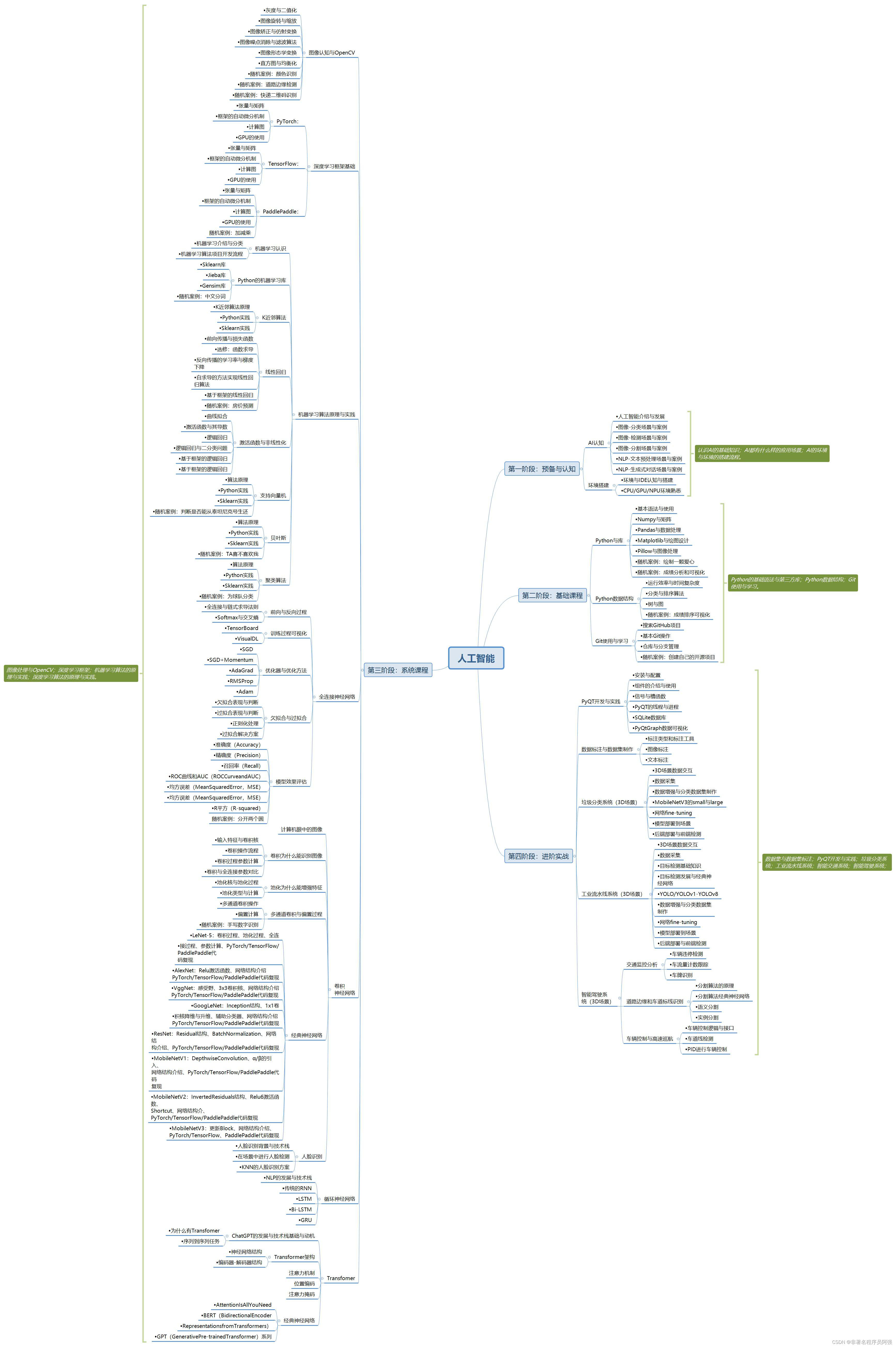前言:为什么要实现运算符重载?
在C语言中,对于内置类型,我们可以根据符号>、<、==等去直接比较大小,但是对于自定义来说,肯定不能直接比较大小,例如下面的日期类,想要比较两个两个日期的大小,或者相差多少天,直接写运算符肯定是不行的。
class Date
{
private:
int _year;
int _month;
int _day;
};
这时候就需要运算符重载出马了!
运算符重载的概念:
运算符重载是具有特殊函数名的函数,也具有其返回值类型,函数名字以及参数列表,其返回值类
型与参数列表与普通的函数类似。
函数名字为:
关键字operator后面接需要重载的运算符符号。
函数原型:
返回值类型 operator操作符(参数列表)。
注意:
- 不能通过连接其他符号来创建新的操作符:比如operator@
- 重载操作符必须有一个类类型参数
- 用于内置类型的运算符,其含义不能改变,例如:内置的整型+,不 能改变其含义
- 作为类成员函数重载时,其形参看起来比操作数数目少1,因为成员函数的第一个参数为隐藏的this
- .* :: sizeof ?: . 注意以上5个运算符不能重载。这个经常在笔试选择题中出现。
日期类运算符实操
头文件(函数的声明)
class Date
{
public:
// 获取某年某月的天数
int GetMonthDay(int year, int month);
//打印日期
void Print();
// 全缺省的构造函数
Date(int year = 1900, int month = 1, int day = 1);
// 拷贝构造函数
// d2(d1)
Date(const Date& d);
// 赋值运算符重载
// d2 = d3 -> d2.operator=(&d2, d3)
Date& operator=(const Date& d);
// 析构函数
~Date();
// 日期+=天数
Date& operator+=(int day);
// 日期+天数
Date operator+(int day);
// 日期-天数
Date operator-(int day);
// 日期-=天数
Date& operator-=(int day);
// 前置++
Date& operator++();
// 后置++
Date operator++(int);
// 后置--
Date operator--(int);
// 前置--
Date& operator--();
// >运算符重载
bool operator>(const Date& d);
// ==运算符重载
bool operator==(const Date& d);
// >=运算符重载
bool operator >= (const Date& d);
// <运算符重载
bool operator < (const Date& d);
// <=运算符重载
bool operator <= (const Date& d);
// !=运算符重载
bool operator != (const Date& d);
// 日期-日期 返回天数
int operator-(const Date& d);
private:
int _year;
int _month;
int _day;
};重载实现(函数的定义):
int Date::GetMonthDay(int year, int month)
{
int arr[13] = { 0,31,28,31,30,31,30,31,31,30,31,30,31 };
//判断闰年
if ((month == 2) && ((year % 4 == 0 && year % 100 == 0) || (year % 400 == 0)))
return 29;
return arr[month];
}
void Date::Print()
{
cout << _year << '-' << _month << '-' << _day;
}
//构造函数的参数声明给,定义不给
Date::Date(int year, int month, int day)
{
_year = year;
_month = month;
_day = day;
}
Date::Date(const Date& d)
{
_year = d._year;
_month = d._month;
_day = d._day;
}
Date& Date::operator=(const Date& d)
{
_year = d._year;
_month = d._month;
_day = d._day;
return *this;
}
Date::~Date()
{
_year = 0;
_month = 0;
_day = 0;
}
bool Date::operator==(const Date& d)
{
return _year == d._year
&& _month == d._month
&& _day == d._day;
}
bool Date::operator<(const Date& d)
{
if (_year < d._year)
return true;
if (_year == d._year && _month < d._month)
return true;
if (_year == d._year && _month == d._month && _day < d._day)
return true;
return false;
}
bool Date::operator>(const Date& d)
{
return !operator<(d) && !operator==(d);
}
bool Date::operator>=(const Date& d)
{
return operator==(d) || operator>(d);
}
bool Date::operator <= (const Date& d)
{
return !operator>(d);
}
bool Date::operator != (const Date& d)
{
return !operator==(d);
}
Date& Date::operator+=(int day)
{
_day += day;
while (_day > GetMonthDay(_year, _month))
{
_day -= GetMonthDay(_year, _month);
_month++;
if (_month == 13)
{
_year++;
}
}
return *this;
}
//前置++和后置++的区别就是构成重载,参数加上int
//在调用的时候,有参数会调用前置++,没有参数会调用后置++
Date& Date::operator++()
{
(*this) += 1;
return *this;
}
// 注意:后置++是先使用后+1,因此需要返回+1之前的旧值,故需在实现时需要先将this保存一份,然后给this+1
// 而temp是临时对象,因此只能以值的方式返回,不能返回引用
Date Date::operator++(int)
{
//调用拷贝构造函数
Date tmp(*this);
(*this) += 1;
return tmp;
}
Date& Date::operator-=(int day)
{
_day -= day;
while (_day <= 0)
{
_month--;
if (_month == 0)
{
_year--;
_month = 12;
}
_day += GetMonthDay(_year, _month);
}
return *this;
}
int Date::operator-(const Date& d)
{
int cnt = 0;
while (*this != d)
{
cnt++;
(*this)--;
}
return cnt;
}
Date& Date::operator--()
{
(*this) -= 1;
return *this;
}
Date Date::operator--(int)
{
Date tmp(*this);
(*this) -= 1;
return tmp;
}
Date Date::operator+(int day)
{
Date tmp(*this);
tmp._day += day;
while (tmp._day > GetMonthDay(tmp._year, tmp._month))
{
tmp._day -= GetMonthDay(tmp._year, tmp._month);
tmp._month++;
if (tmp._month == 13)
{
tmp._year++;
}
}
return tmp;
}
重载过程中的注意点:
- 构造函数如果声明和定义分离,声明需要将参数赋缺省值,定义不需要写,以防混淆。
- 传参数时尽量都要用引用传参,可以提高传参的效率
- 传返回值时,如果返回值在调用完这个函数没有被销毁,需要引用返回,如果销毁了,直接返回。
- 多复用已经实现的函数!
赋值运算符重载:
1. 赋值运算符重载格式
- 参数类型:const T&,传递引用可以提高传参效率
- 返回值类型:T&,返回引用可以提高返回的效率,有返回值目的是为了支持连续赋值检测是否自己给自己赋值
- 返回*this :要复合连续赋值的含义
2、前置++后置++的重载区别
// 前置++和后置++都是一元运算符,为了让前置++与后置++形成能正确重载
// C++规定:后置++重载时多增加一个int类型的参数,但调用函数时该参数不用传递,编译器自动传递
// 注意:后置++是先使用后+1,因此需要返回+1之前的旧值,故需在实现时需要先将this保存一份,然后给this+1(调用拷贝构造函数)
// 而temp是临时对象,因此只能以值的方式返回,不能返回引用
this指向的对象函数结束后不会销毁,故以引用方式返回提高效率
输入流输出流操作符重载
为什么cin cout能够自动识别任意类型的数据呢?
本质上就是函数的重载!
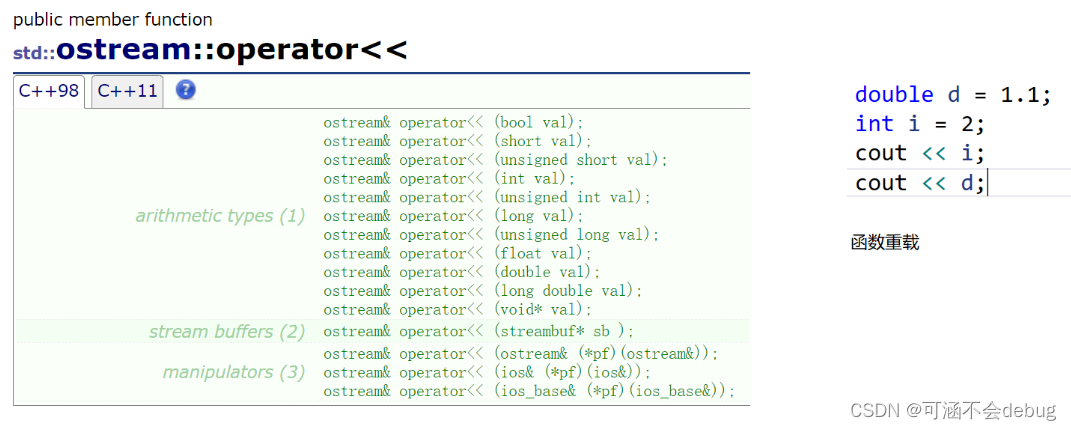
原码:
ostream& operator<<(ostream& out, const Date& d)
{
out << d._year << "年" << d._month << "月" << d._day << "日" << endl;
return out;
}
istream& operator>>(istream& in, const Date& d)
{
in >> d._year >> d._month >> d._day;
return in;
}
总结:
其他的运算符一般是实现成成员函数,<< >>运算符必须是实现到全局,这样才能让流对象做第一个参数,才符合可读性。不然可读性很差,像下面定义在类的内部:
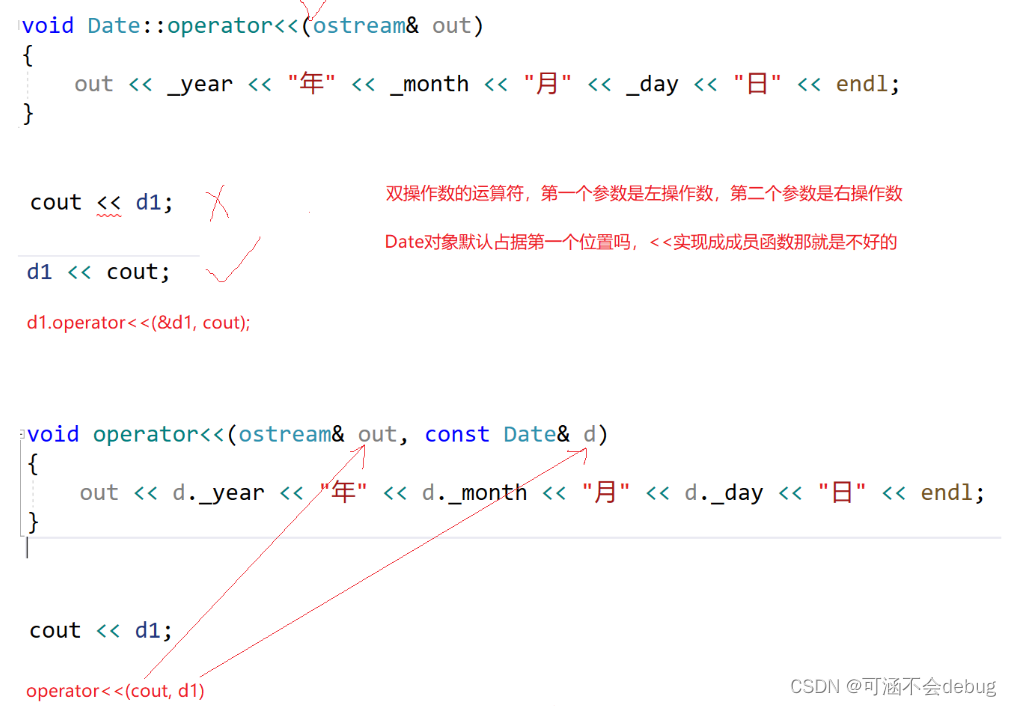
重载流操作符为什么必须用引用?
如果我们使用值传送来传递一个流给函数,那么在函数里要生成一个该流的临时变量,生成临时变量的时候,就要调用对应的拷贝构造函数,并且这个拷贝构造函数必须是以一个值传送的流作为参数的——但是流就是没有这样的拷贝构造函数!
分析:
流本质是为了解决,自定义类型的输入和输出问题,printf scanf 无法解决自定义类型的输入输出问题
面向对象 + 运算符重载解决!


